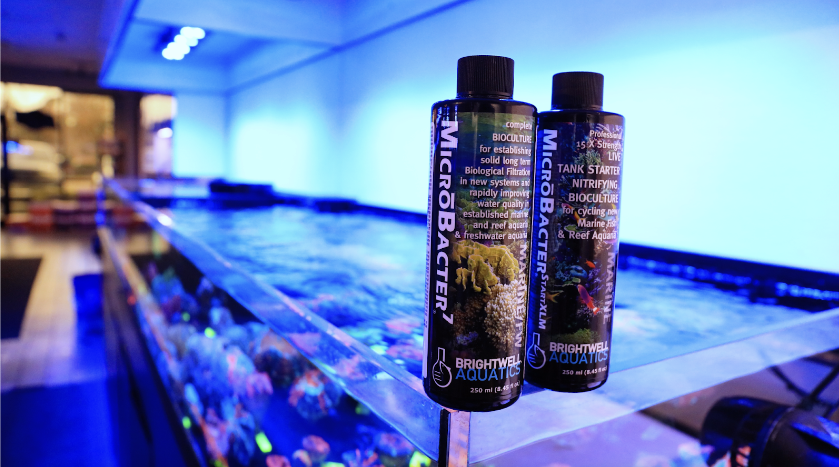The issue of bacteria blooms, often denoted by cloudy water from rapidly reproducing heterotrophic bacteria is a prevalent issue within the aquarium hobby. More often than not, these bacteria blooms are virtually harmless to both fish and coral, but when there is a serious bloom where your water becomes nearly opaque, both your fish and coral can be at risk. Here we’ll talk about different types/strains of bacteria, their effects, preventions, and treatments to mitigate their effects.
Types of Bacteria found within marine aquariums (with commonly found strains)
1. Nitrifying Bacteria (Beneficial Bacteria)
- Nitrosomonas: An integral bacteria to the nitrogen cycle, Nitrosomonas converts ammonia into nitrites within the water column. Although ammonia is highly toxic to fish within a reef tank, it is the foundation to the nitrogen cycle.
- Nitrobacter and Nitrospira: Both of these bacteria finish the nitrogen cycle and convert nitrite into nitrate which acts as a food for coral to further enhance growth and coloration.
2. Heterotrophic Bacteria:
There are 3 types of heterotrophic bacteria: parasitic, saprophytic (obtaining food from organic matter), and symbiotic.
- Parasitic: While detrimental, understanding their behavior is key to preventing and treating infections in the aquarium.
- Vibrio Species: A notable example of parasitic bacteria in marine aquariums. These bacteria are pathogenic and can cause diseases in fish and invertebrates. They feed off their hosts, often leading to infections or illnesses. Some common diseases caused by
- Vibriosis: A disease that can cause ulcers, skin lesions, and even systemic infections in fish.
- Shell Disease in Crustaceans: Characterized by erosion or pitting on the shells of shrimps or crabs.
- Saprophytic (obtaining food from organic matter): Essential for breaking down organic waste, thus maintaining water quality and preventing nutrient buildup.
- Pseudomonas fluorescens: This is a saprophytic bacteria commonly found in water and soil. It plays a crucial role in decomposing organic matter, such as dead macroalgae, uneaten fish food, and fish waste. By breaking down these materials, Pseudomonas fluorescens helps maintain the nutrient balance in the aquarium and prevents the accumulation of harmful substances. They are generally not harmful to healthy fish but can cause issues in immunocompromised or stressed individuals.
- Symbiotic: Contribute to a balanced ecosystem by aiding in nutrient cycling, especially beneficial in planted marine tanks.
- Rhizobium Species: While more commonly associated with plant roots, some species of Rhizobium can also be found in marine environments where they establish symbiotic relationships. In an aquarium setting, they might not play as direct a role as in natural oceanic ecosystems, but in cases where there are live macroalgae, they can form symbiotic relationships. These bacteria fix nitrogen, converting atmospheric nitrogen into a form that plants can use, thereby aiding in nutrient cycling and promoting plant or algae growth.
Causes of Bacteria Blooms
Bacteria blooms often occur due to an imbalance in the aquarium ecosystem. Common causes include:
- Overfeeding: Excess food decays, providing a food source for bacteria.
- Poor Water Quality: High levels of nutrients like nitrates and phosphates can fuel bacterial growth.
- Inadequate Filtration: Poor filtration can lead to a build-up of organic waste.
- New Tank Syndrome: In newly set-up tanks, bacterial colonies are not fully established, leading to fluctuations in bacteria populations.
Prevention Methods
Preventing bacteria blooms involves maintaining a balanced and healthy aquarium:
- Regular Water Changes: This helps to reduce nutrient levels and remove organic waste.
- Proper Feeding: Avoid overfeeding and remove uneaten food.
- Adequate Filtration: Ensure your filtration system is appropriate for your tank size and bioload.
- Monitoring Water Parameters: Regularly test for nitrates, phosphates, and other key parameters.
Treating Bacteria Blooms
If a bloom occurs, it's important to address it promptly:
- Increase Water Changes: This can help to reduce the excess nutrients that bacteria feed on.
- UV Sterilizers: These devices can help to kill free-floating bacteria.
- Chemical Filtration: Using media like activated carbon can help remove organic compounds from the water.
- Adding Beneficial Bacteria: Commercially available beneficial bacteria can help re-establish a healthy bacterial balance.
Impact on Corals and Fish
Bacteria blooms can significantly impact the inhabitants of your aquarium:
- Reduced Oxygen Levels: Bacterial blooms can deplete oxygen, stressing fish and corals. To help counteract this, the use of skimmers and air stones will help to oxygenate the water and ensure your animals ability to breath and overall help reduce stress.
- Blocked Light: Dense blooms can reduce light penetration, affecting photosynthetic corals. Leveraging a UV sterilizer you can rapidly kill the bloom and increase water clarity.
- Toxin Production: Some bacteria can produce toxins harmful to fish and corals.
- Disease: Pathogenic bacteria can cause diseases in stressed or weakened fish and corals. However, this is a very very rare situation to occur.
In conclusion,there are a wide variety of bacteria/bacteria blooms that can occur in our aquarium spaces. The best thing to do in case of a bloom is to identify exactly what you are dealing with, and where the source came from. Understanding the microbial levels of our systems will not only get us more in tune with our systems, but help establish the building blocks of a strong reef microbiome.

